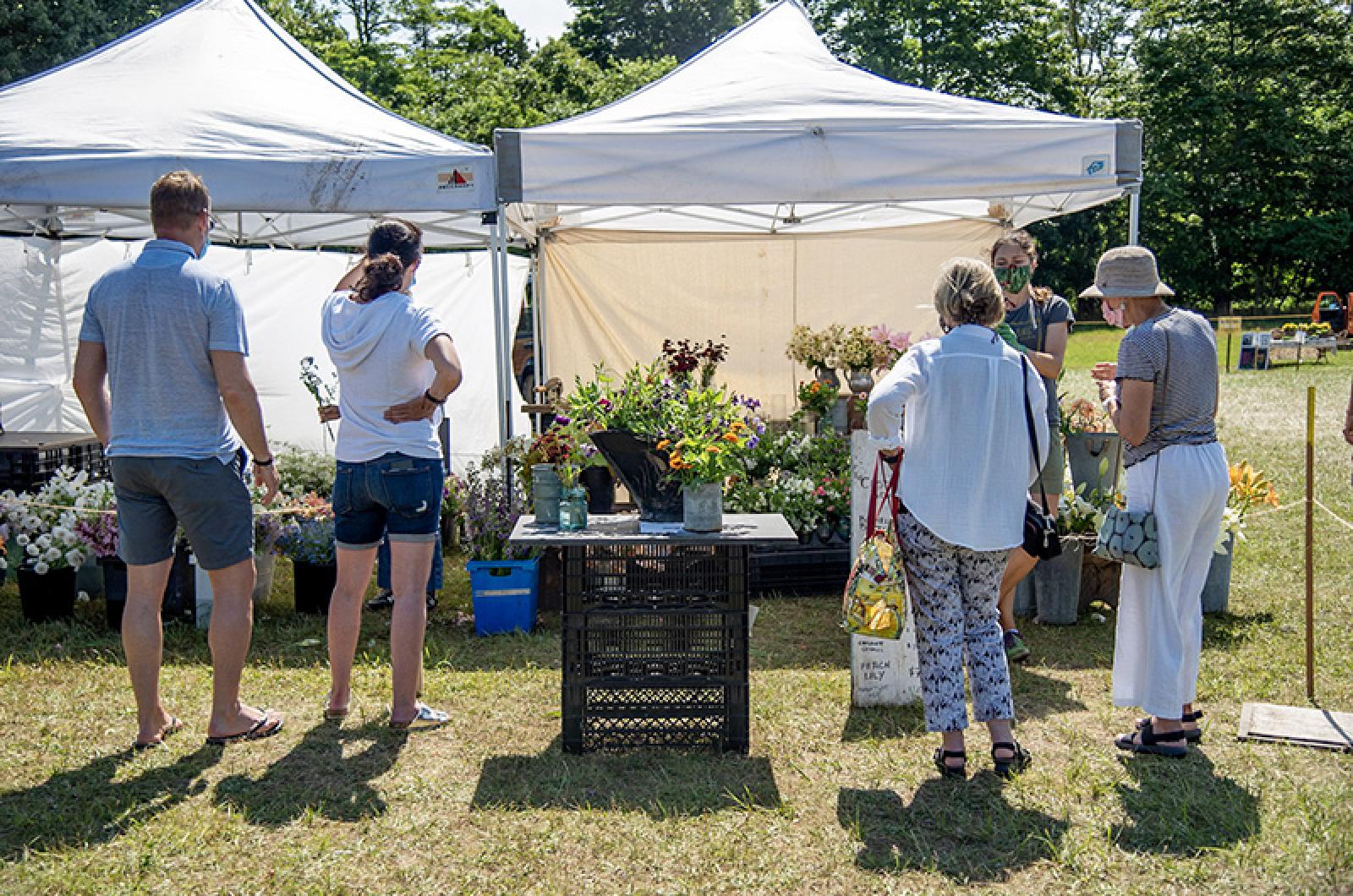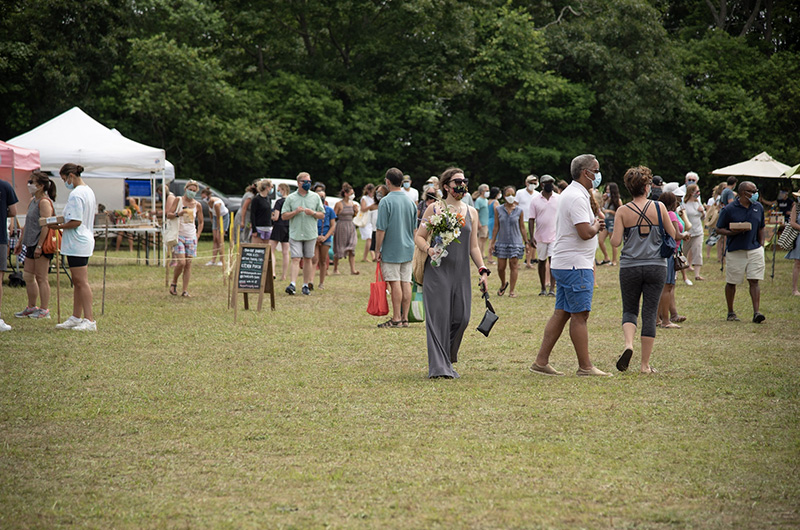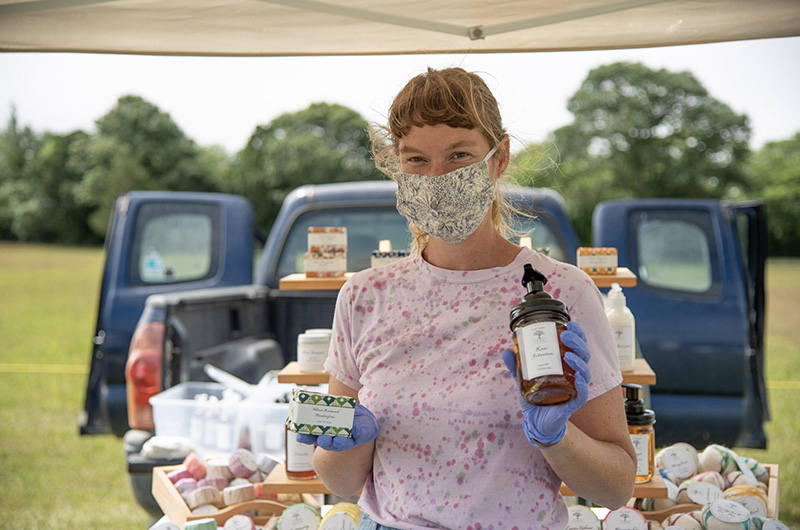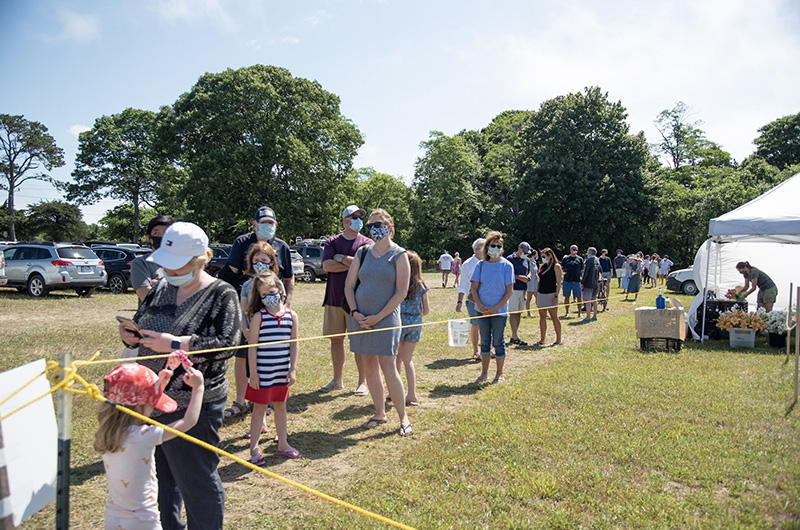The co-managers of the West Tisbury Farmers’ Market stood alongside a life-sized cutout of Dr. Anthony Fauci last Saturday morning. It was the ninth market of the year, and Collins Heavener and Olivia Rabbitt were keeping a clicker-count of the crowd size, ensuring that the grassy field sectioned off with rope did not exceed 250 people.
Since the market began in mid-June, more than 11,000 market-goers have passed through the gate. The number could be a record breaker, they said, although no one knows for sure because precise counts have never been kept.
“We are nine markets in. We have had consistent compliance between the vendors and customer and our vendors have been doing July-type sales since June,” Mr. Heavener said. “I think it’s fair to say, only now, that it is a success. We are very happy about that.”
Early on in the pandemic, Massachusetts declared farmers’ markets an essential business. Right away Mr. Heavener and Ms. Rabbitt began crafting a plan for a new West Tisbury Farmers’ Market.
“We have 50 vendors who rely on us, several of them exclusively for their income,” Mr. Heavener said. “We have a significant responsibility to make sure it goes smoothly. Olivia and I took that very seriously. We knew we would have to really do our homework and put together a plan that would be palatable to the boards of health and selectmen, and above all safe to vendors and customers.”
It was the start of what would be a year of dramatic change for the venerable farmers’ market.
To begin with, the location was moved to the fairgrounds at the Agricultural Society, which required clearing a gauntlet of approvals from both the society and the town.
The relocation of the market from the old Grange hall in the heart of West Tisbury was not a new idea and has been discussed repeatedly in recent years, especially as huge traffic jams began to be a source of growing concern in the village on market days.
But the pandemic was forcing an all-new new hand to be played, if it could be played at all.
There was much to do: plotting out the space to create ample distance among vendors, creating a plan for traffic flow — cars and people — and designing a safe, clean outdoor marketplace.
Many vendors, some deeply rooted in tradition, others concerned about infection, were reluctant. But other new vendors were interested.
Mr. Heavener said all told, 12 vendors dropped out and nine new ones joined the market. He said some anchor farms, such as Ghost Island Farm and Old Town Gardens, were too busy tending their own farm stands to set up at the market this year. Of the nine new vendors, he said two are oyster farmers and two are fishermen. But many anchor farms, including North Tabor, Morning Glory, Beetlebung, Grey Barn and Flat Point Farm, remain. Kitchen Porch is still a vendor. Flower vendors and an artisan pizza maker have joined the ranks too.
There are many other changes this year. Mr. Heavener said 95 per cent of transactions were cash last year, while this year almost all transactions are done by credit card, or some other contactless payment such as Venmo. No eating or drinking is allowed inside the market. And while the market, still held on Saturdays and Wednesdays, is not the shoulder-to-shoulder social experience it has been in the past, it remains airy and pleasant in this year of new normals. People queue up in the pastoral field, faces covered beneath sun hats, entering and exiting the market in one circuitous loop. Vendors operate from beneath small tents, spaced apart. An open-air handwashing station is set up with fresh water and foamy soap from a local farm. Dr. Fauci is there, wearing his medical face mask of course.
Masks are required for all.
“It’s not a debate,” Mr. Heavener said. “You wear a mask or you don’t come to the market.”
Vendors report sales are up across the board, and many have adapted to fit the new demand.
“Our market is totally different than it has been in years past,” said Jefferson Munroe, a poultry farmer who owns The Larder but has re-branded as Komrade Fried Chicken for the market this year. “Our meat sales are much higher than they have been on a market basis. People are cooking at home, and have a little more money in their food budget,” he said.
“With restaurants basically closed, it seemed to be the perfect year to get into it,” said Dan Martino, whose company Cottage City Oysters joined the market this year. “It’s been a steady income for us, which has been a huge help this year.”
“We are doing very well this year, better than last,” said Gus Leaf, co-owner of MV Smokehouse. “This is our retail store, the farmers’ market.”
Mr. Heavener said the market incorporated this year. “It truly is a business and needs to be thought of as a business,” he said. “We are doing everything we can to keep it going.”
He said permission to operate at the fairgrounds is a one-time deal for this summer, but he hoped the strong success of the market this summer has the potential to change the conversation. “It will be easier to have that conversation in the future now that we have the experience of being there,” he said.
Historically, the market co-managers have been volunteers, working about 300 combined hours. After weeks of Zoom meetings with the state Department of Agriculture, town officials and vendors, Mr. Heavener and Ms. Rabbitt said they had worked 400 hours before the first market opened.
When the market incorporated, the collective group of vendors voted to grant the co-managers a modest salary, although their hours have already far exceeded the pay scale.
All the unpaid work aside, Mr. Heavener pointed to shifting paradigms as a positive — and important — sign for the market.
“The pandemic has shifted people’s understanding of the food supply system,” he said. “There were breakdowns in the food supply chain, and I think that has put some emphasis on the local food producers,” he said. “People are thinking about where their food comes from. I hope this is a shift that carries on.”














Comments (2)
Comments
Comment policy »